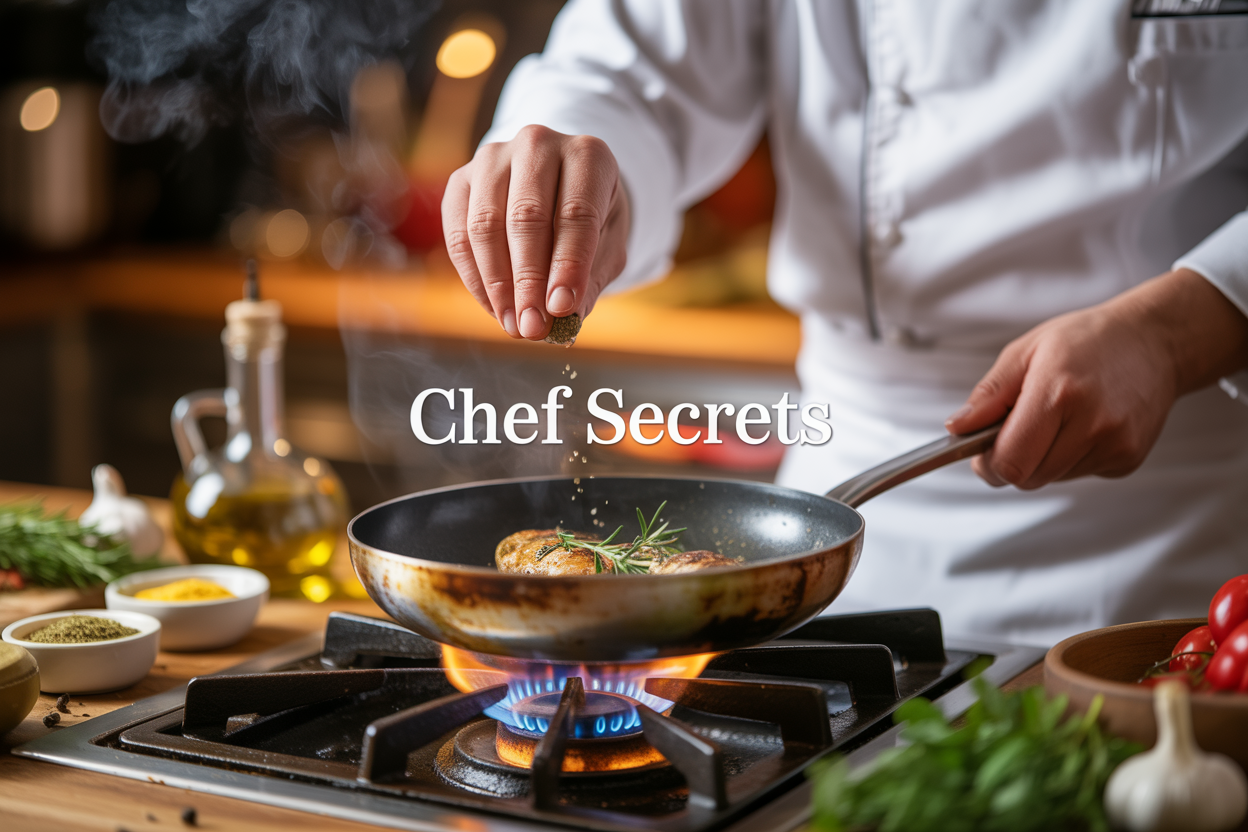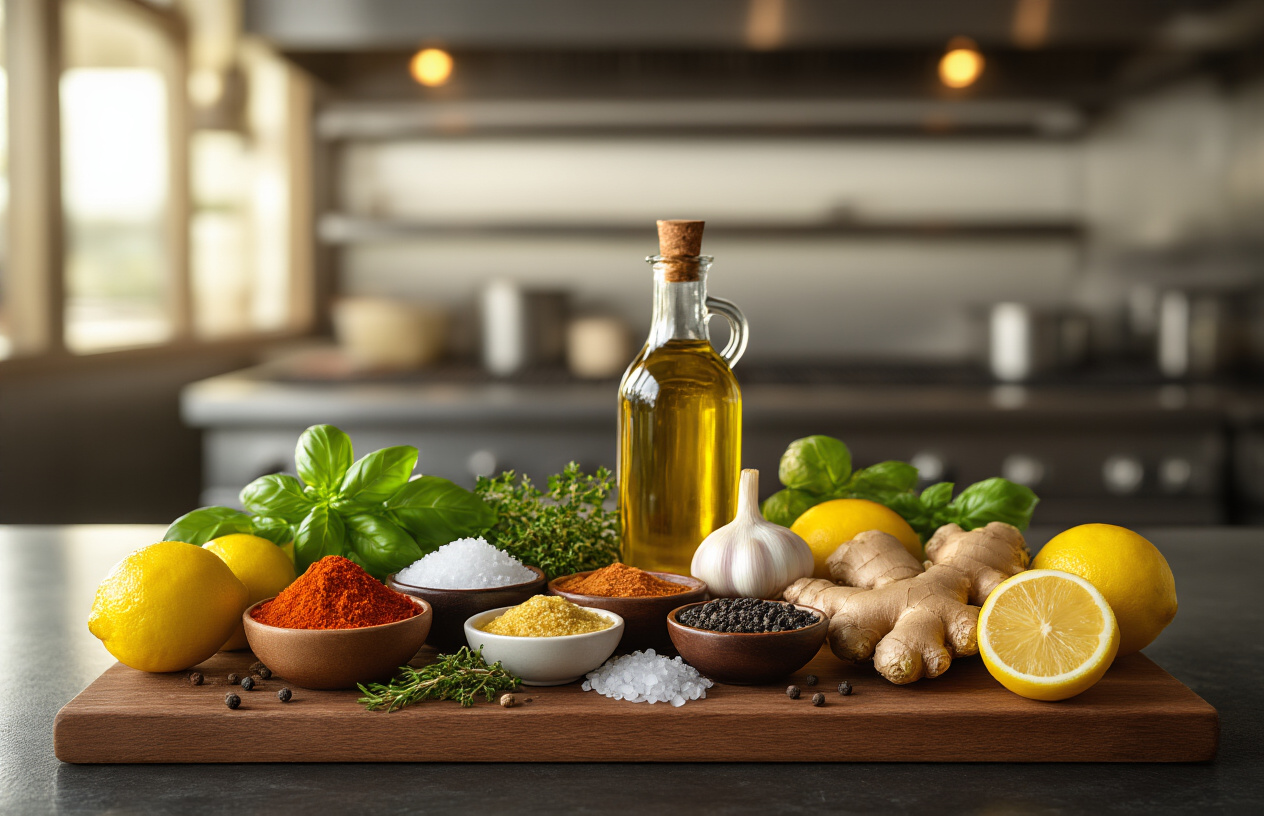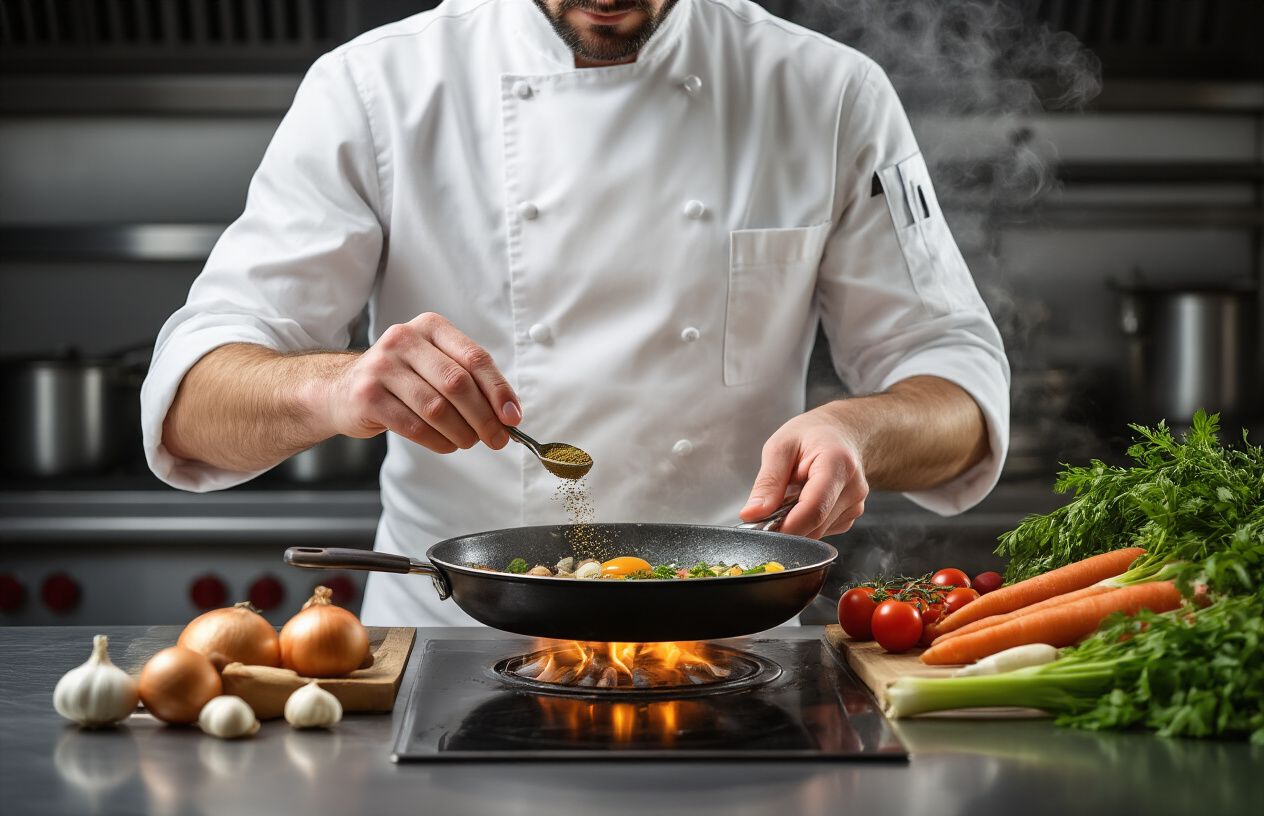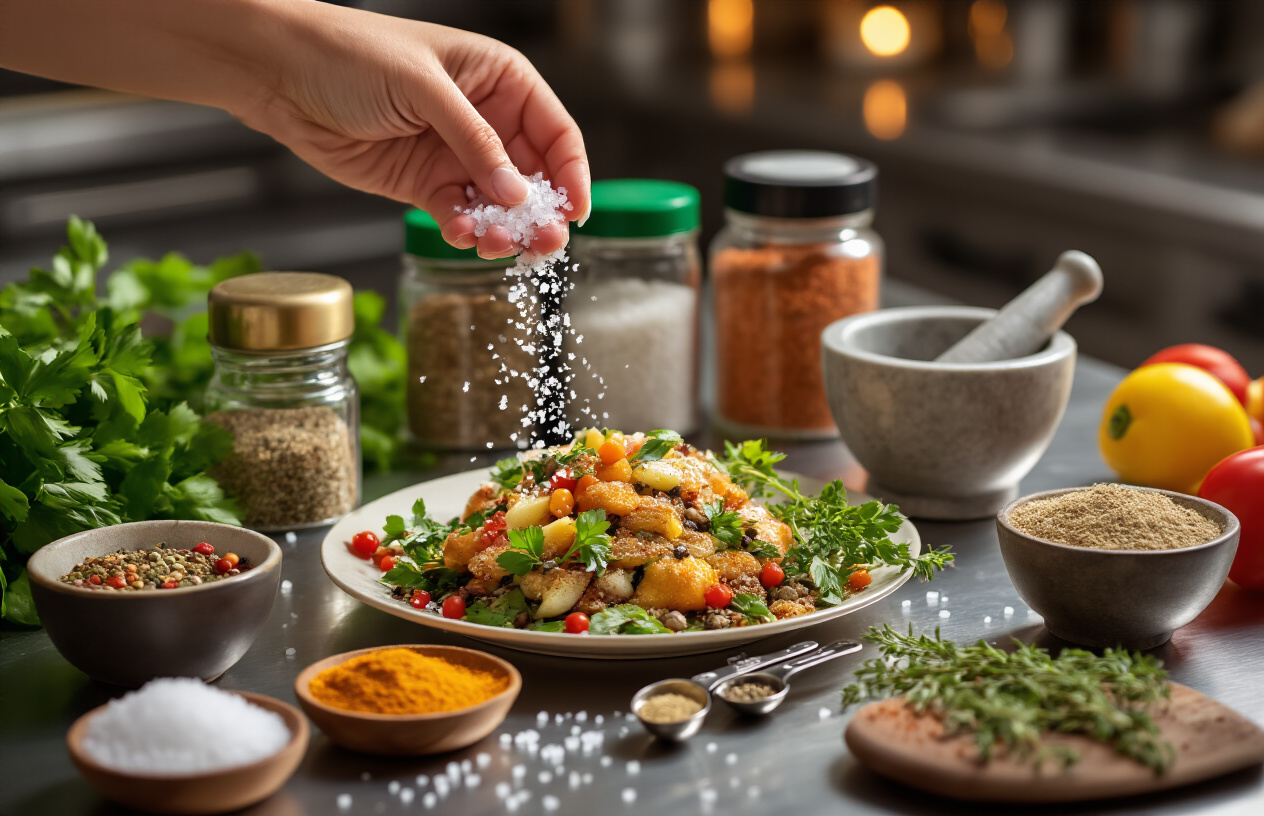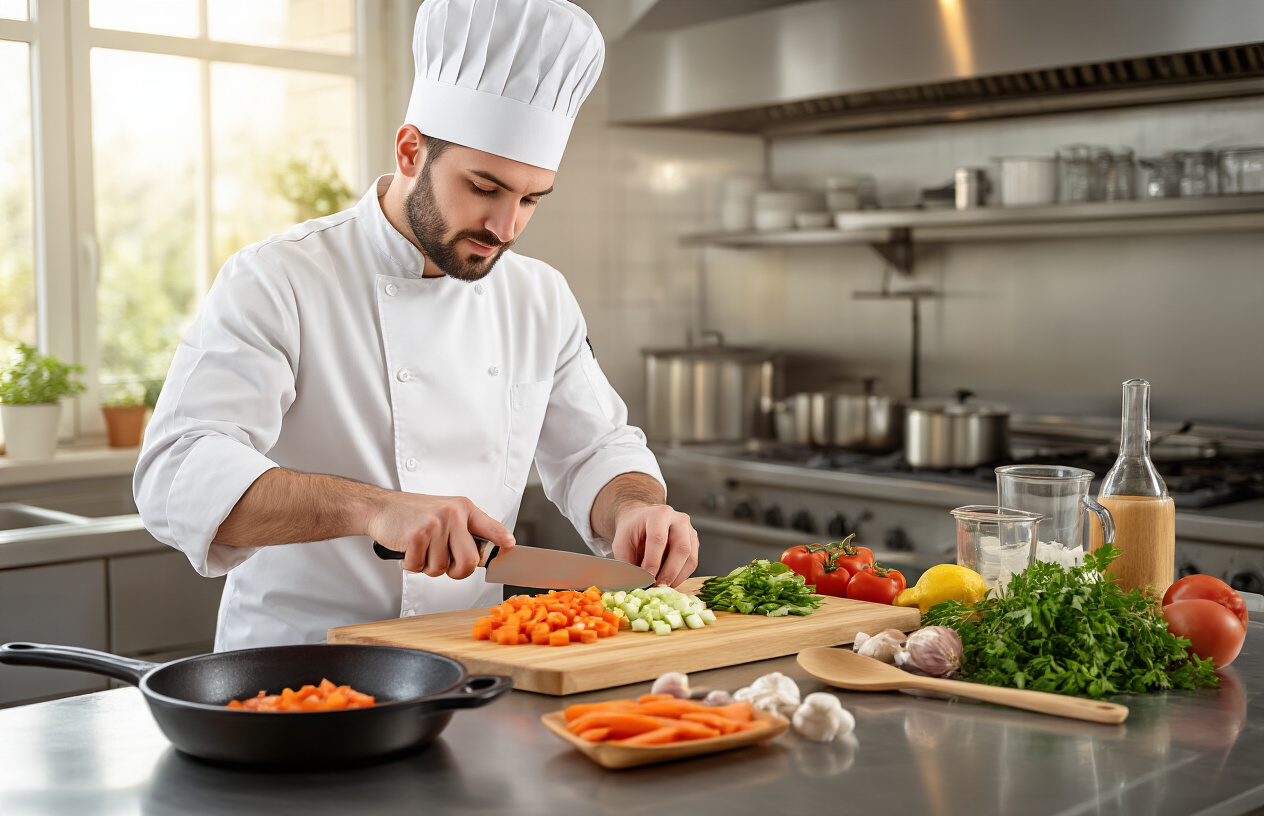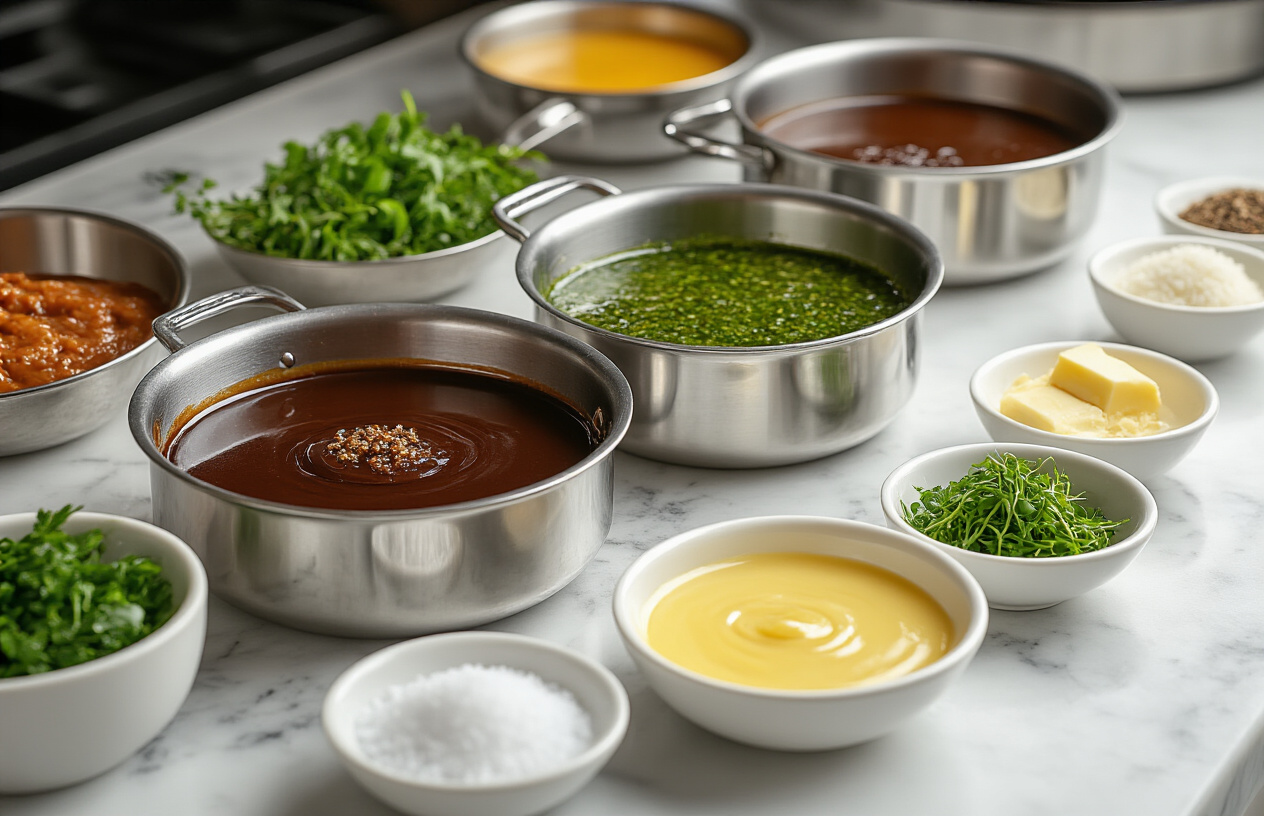Ever wonder why restaurant food tastes so much better than your home cooking? Professional chefs use specific restaurant chef secrets and cooking fundamentals that turn basic ingredients into incredible dishes.
This guide is for home cooks who want to understand professional cooking techniques and learn how chefs make food taste better. You'll discover the flavor building methods that separate restaurant kitchens from home kitchens.
We'll cover the chef seasoning tips that build layers of taste in every dish, plus the professional chef techniques for transforming simple ingredients into restaurant-quality meals. You'll also learn the sauce-making skills that give dishes their final wow factor and help you achieve restaurant quality cooking at home.
Master the Foundation of Flavor Building
Layer salt throughout the cooking process instead of adding it at the end
Professional chefs understand that salt isn't just a final seasoning—it's a cooking tool that transforms ingredients at every stage. When you add salt early and throughout cooking, it penetrates food completely, drawing out natural flavors and creating depth that last-minute seasoning can't achieve.
Start seasoning proteins 40 minutes before cooking to allow salt to penetrate and break down muscle fibers, creating more tender, flavorful results. For vegetables, salt them as they hit the pan to draw out moisture and concentrate flavors. This restaurant chef secret ensures every bite tastes intentional rather than flat.
The key lies in using different types of salt strategically. Kosher salt works perfectly for cooking, while finishing salts like flaky sea salt add textural contrast when sprinkled just before serving. This layered approach mirrors professional cooking techniques used in restaurant kitchens worldwide.
Build umami depth with fish sauce, soy sauce, and tomato paste
Restaurant chefs rely on umami-rich ingredients to create that mysterious "something special" flavor that keeps diners coming back. These chef seasoning tips center around three powerhouse ingredients that add savory depth without overwhelming other flavors.
Fish sauce works magic in non-seafood dishes—just a teaspoon in beef stew or tomato sauce creates incredible depth. Soy sauce adds complexity to marinades and braised dishes, while tomato paste becomes a secret weapon when sautéed until it darkens and caramelizes.
Professional chef techniques often involve combining these umami builders. Try mixing a tablespoon of tomato paste with a splash of soy sauce when building the base of soups or stews. This combination creates layers of savory complexity that distinguish restaurant-quality cooking from basic home meals.
Balance acidity with vinegars and citrus to brighten every dish
Acidity acts like a spotlight on flavors, making everything taste more vibrant and balanced. Restaurant chefs use acid strategically throughout cooking, not just as a finishing touch. Different acids serve different purposes in flavor building methods.
Wine vinegar added during cooking helps tenderize proteins and adds subtle tang, while rice vinegar provides gentle acidity perfect for Asian-inspired dishes. Fresh citrus juice brightens heavy sauces and cuts through rich flavors, creating balance that prevents palate fatigue.
The timing matters as much as the type. Add vinegar early to mellow its sharpness through cooking, but reserve fresh citrus juice for the final moments to preserve its bright, fresh impact. This balance between cooked and fresh acidity creates the complex flavor profiles found in professional kitchens.
Create complexity by combining multiple cooking fats
Single-fat cooking limits flavor potential. Restaurant kitchens combine different fats to build layers of richness and complexity that home cooks often miss. Each fat contributes unique flavors and cooking properties that professional cooking techniques exploit masterfully.
Start with neutral oil for high-heat searing, then finish with butter for richness and browning. Add bacon fat or duck fat to vegetables for smoky depth. Olive oil works beautifully for medium-heat cooking and adds fruity notes that complement Mediterranean flavors.
| Fat Combination | Best Use | Flavor Profile |
|---|---|---|
| Butter + Neutral Oil | Pan-seared proteins | Rich, nutty finish |
| Bacon Fat + Olive Oil | Roasted vegetables | Smoky, savory depth |
| Duck Fat + Herbs | Crispy potatoes | Luxurious, aromatic |
This multi-fat approach creates the complex, satisfying flavors that make restaurant food memorable. Each fat contributes different flavor compounds and cooking properties, building depth that single fats simply cannot achieve.
Transform Ordinary Ingredients with Professional Techniques
Brown Proteins Properly to Develop Rich Caramelized Flavors
Professional chefs understand that proper browning creates the foundation for incredible flavor. The Maillard reaction occurs when proteins and sugars react under high heat, producing hundreds of complex flavor compounds that home cooks often miss. Start with completely dry protein - pat meat, poultry, or fish with paper towels and let it rest at room temperature for 15-20 minutes before cooking.
Heat your pan until it's smoking hot before adding oil. The protein should sizzle aggressively when it hits the surface. Resist the urge to move or flip too early - proper caramelization takes 3-4 minutes per side for most cuts. Restaurant chefs know that golden-brown coloring isn't just visual appeal; it's concentrated umami that transforms ordinary chicken breast into something extraordinary.
For vegetables, the same principles apply. Mushrooms should release their moisture and develop deep brown edges. Onions need patience to reach that perfect caramelized sweetness that adds depth to any dish.
Deglaze Pans to Capture Concentrated Taste Essences
Those brown bits stuck to your pan after searing? That's liquid gold. Professional cooking techniques always include deglazing to capture these concentrated flavor compounds called fond. Add wine, stock, or even water to a hot pan immediately after removing your protein.
The liquid will bubble vigorously, loosening all those caramelized particles. Scrape with a wooden spoon to incorporate every bit of flavor. This technique transforms simple pan juices into restaurant-quality sauces that home cooks often discard by washing their pans too quickly.
Different liquids create different flavor profiles - white wine for delicate proteins, red wine for beef, and stock for deeper, more complex tastes.
Toast Spices and Aromatics Before Adding Liquids
Raw spices taste flat compared to their toasted counterparts. Chef seasoning tips always emphasize this crucial step that takes seconds but delivers exponential flavor returns. Heat whole spices in a dry pan for 30-60 seconds until fragrant, then grind fresh for maximum potency.
Garlic, ginger, and onions benefit from the same treatment. Cook these aromatics in oil until they release their essential oils and become fragrant. This creates a flavor base that penetrates throughout your entire dish rather than sitting on the surface.
Even ground spices improve with brief toasting. Add them to hot oil for 15-20 seconds before incorporating other ingredients.
Use High Heat Strategically for Maximum Flavor Development
Restaurant chefs master heat control to build layers of flavor that home cooks struggle to achieve. High heat isn't just about speed - it's about creating texture contrasts and concentrated flavors impossible at lower temperatures.
Stir-fries depend on intense heat to create "wok hei" - that smoky, slightly charred flavor that defines great Asian cuisine. Vegetables should cook quickly while retaining crunch, and proteins should sear while staying tender inside.
Professional chef techniques include preheating pans properly, using appropriate oils with high smoke points, and working in small batches to maintain temperature. Cast iron and carbon steel pans retain heat better than stainless steel for these high-heat applications.
| Temperature Zone | Best For | Result |
|---|---|---|
| High Heat (400°F+) | Searing proteins, stir-frying | Caramelization, crispy textures |
| Medium-High (350-400°F) | Browning vegetables, reducing sauces | Even cooking, controlled browning |
| Medium (300-350°F) | Sautéing aromatics, cooking through | Gentle cooking, flavor development |
Elevate Dishes with Strategic Seasoning Methods
Season proteins well in advance to penetrate deep into the meat
Professional chefs know that great flavor starts hours before cooking begins. While home cooks often season meat just before it hits the pan, restaurant chef secrets involve salting proteins anywhere from 2 to 24 hours in advance. This technique, called dry brining, allows salt to penetrate deep into muscle fibers, breaking down proteins and creating incredibly tender, flavorful results.
The science behind this professional cooking technique is simple: salt draws moisture from the meat initially, then that moisture dissolves the salt, creating a concentrated brine that gets reabsorbed. For steaks, season them 2-4 hours ahead. For whole chickens or roasts, 12-24 hours produces restaurant-quality results. The key is using kosher salt or sea salt at about 1 teaspoon per pound of meat.
Finish dishes with flaky sea salt for textural contrast
The final sprinkle of flaky sea salt transforms ordinary dishes into extraordinary ones. Chefs reach for Maldon, fleur de sel, or similar finishing salts because they provide bursts of salinity and delightful crunch that regular table salt can't match. This chef seasoning tip works magic on everything from grilled vegetables to chocolate desserts.
Apply finishing salt just before serving to preserve its distinctive texture. The large, irregular crystals create pockets of intense flavor that awaken taste buds. Try sprinkling flaky salt on:
-
Grilled meats and fish
-
Roasted vegetables
-
Fresh tomatoes with olive oil
-
Caramel desserts
-
Even cocktail rims
Add fresh herbs at multiple stages for layered herbal notes
Smart chefs don't just garnish with herbs—they build herbal complexity throughout the cooking process. This flavor building method involves adding sturdy herbs like rosemary and thyme early in cooking for deep, infused flavors, while saving delicate herbs like basil and cilantro for the final moments to preserve their bright, fresh notes.
The timing makes all the difference:
| Herb Type | When to Add | Examples |
|---|---|---|
| Hardy herbs | Early cooking stages | Rosemary, thyme, oregano |
| Tender herbs | Last few minutes | Basil, parsley, cilantro |
| Delicate herbs | Just before serving | Chives, mint, dill |
Incorporate aromatic garnishes that complement the main flavors
Restaurant quality cooking at home means thinking beyond basic parsley sprinkles. Professional chefs choose garnishes that enhance and echo the dish's core flavors while adding visual appeal. A sprinkle of toasted sesame seeds on Asian-inspired dishes, crispy fried shallots on soups, or fresh microgreens on salads all serve specific flavor purposes.
The best garnishes engage multiple senses—they smell amazing, provide textural interest, and taste incredible. Consider these professional chef techniques:
-
Toast spices or nuts before sprinkling for deeper flavor
-
Use citrus zest to brighten rich dishes
-
Add crunchy elements like toasted breadcrumbs or seeds
-
Choose garnishes that mirror ingredients already in the dish
Apply Time-Tested Cooking Fundamentals
Control Temperature Precisely for Optimal Texture and Taste
Professional chefs live by their thermometers, and temperature control separates restaurant-quality dishes from home cooking disasters. Every protein has a sweet spot where it transforms from tough and chewy to tender and juicy. For chicken breast, that magic number is 165°F, but the real secret lies in pulling it off heat at 160°F and letting carryover cooking finish the job.
Different cooking methods demand different temperature approaches. When searing steaks, restaurant chefs heat their pans to screaming hot temperatures—around 400-450°F—to create that coveted crust while keeping the interior perfectly pink. Slow-braised meats, on the other hand, cook low and slow at 275-300°F for hours, breaking down tough connective tissues into silky gelatin.
Professional cooking techniques rely heavily on zone cooking. Chefs create hot and cool zones on grills, allowing them to sear proteins over high heat before moving them to gentler zones for even cooking. This method prevents the common home cooking mistake of charred outsides and raw centers.
| Protein | Target Internal Temp | Pull Temperature | Rest Time |
|---|---|---|---|
| Chicken Breast | 165°F | 160°F | 5-8 minutes |
| Beef Steak (Medium-rare) | 130°F | 125°F | 5-10 minutes |
| Pork Tenderloin | 145°F | 140°F | 5 minutes |
| Salmon | 145°F | 140°F | 3-5 minutes |
Rest Cooked Proteins to Redistribute Juices Evenly
The resting period is where restaurant chef secrets truly shine. When proteins cook, heat forces moisture toward the surface and center. Cutting immediately after cooking releases all those precious juices onto the cutting board instead of staying in the meat where they belong.
Restaurant chefs tent their cooked proteins with foil and let them rest on warm plates or in low ovens. During this time, muscle fibers relax and reabsorb the redistributed juices. A properly rested steak will be evenly moist from edge to edge, while an unrested one bleeds its flavor all over the plate.
Resting times vary by size and cooking method:
-
Steaks and chops: 5-10 minutes
-
Whole chickens: 10-15 minutes
-
Large roasts: 15-30 minutes
-
Grilled fish: 3-5 minutes
Professional chefs use this resting time productively, preparing sauces, plating vegetables, or warming serving dishes. They understand that patience during this crucial step makes the difference between good food and exceptional dining experiences.
Taste and Adjust Seasoning Continuously Throughout Cooking
Top restaurant chefs taste their food constantly—sometimes dozens of times during a single dish preparation. This isn't about perfectionism; it's about understanding how flavors develop and change throughout the cooking process.
Salt behaves differently at various cooking stages. Added early, it penetrates ingredients and draws out natural flavors. Added late, it provides surface seasoning and brightness. Chefs know when each approach works best for different elements of a dish.
Professional chef techniques include keeping small spoons nearby for constant tasting, adjusting not just salt but also acid levels with lemon juice or vinegar, and balancing sweetness when needed. They taste after each major step: after browning aromatics, after adding liquids, during simmering, and before final plating.
Smart seasoning adjustments happen in layers:
-
Early seasoning: Salt meats 30-60 minutes before cooking
-
Mid-cooking adjustments: Balance acidity and heat levels
-
Final touches: Bright herbs, finishing salts, or acid for pop
Restaurant chefs also consider how flavors will concentrate as liquids reduce. They season lightly at first, knowing that a sauce that tastes perfect when thin might become oversalted after reducing by half.
Create Restaurant-Quality Sauces and Finishing Touches
Reduce liquids to concentrate flavors into powerful bases
Professional chefs know that reduction is one of the most powerful restaurant chef secrets for building intense flavor. When you simmer wine, stock, or cream over medium heat, the water evaporates and leaves behind concentrated flavor compounds that pack a serious punch. A cup of red wine reduced to two tablespoons becomes a flavor bomb that transforms any sauce.
Start with quality liquids - good wine, homemade stock, or fresh cream. Pour your chosen liquid into a wide, heavy-bottomed pan to maximize surface area for faster evaporation. Keep the heat at a gentle simmer, not a rolling boil, which can make liquids taste harsh. Watch carefully as reductions can go from perfect to burnt quickly.
Wine reductions work beautifully with beef and pork dishes, while cream reductions pair perfectly with chicken and seafood. Stock reductions create the backbone for gravies and pan sauces that rival any restaurant.
Mount sauces with cold butter for silky richness
Butter mounting transforms thin, separated sauces into restaurant-quality masterpieces with incredible richness and shine. This professional cooking technique involves whisking cold butter pieces into hot sauces just before serving.
Remove your sauce from direct heat and add cold butter cubes one at a time, whisking constantly. The cold butter emulsifies with the warm liquid, creating a velvety texture that coats the back of a spoon. Never let mounted sauces boil again - the emulsion will break and you'll end up with greasy, separated liquid.
This chef cooking method works with pan sauces, wine reductions, and even simple stock-based sauces. The butter adds richness without heaviness and gives sauces that glossy, professional appearance you see in restaurants.
Add bright acidic elements just before serving
Acid is the secret weapon that makes restaurant food taste better by brightening and balancing rich flavors. Chefs add acidic elements at the very end of cooking to preserve their fresh, vibrant impact.
Fresh lemon juice, lime juice, or quality vinegar can transform heavy cream sauces, rich gravies, and butter-based preparations. Even a few drops can cut through fat and make flavors pop. White wine vinegar works beautifully with herb sauces, while balsamic adds depth to meat dishes.
Don't add acid too early - heat destroys the bright notes that make these ingredients so effective. Keep citrus wedges, vinegar, or wine handy for that final flavor adjustment that elevates your dish from good to restaurant-quality.
Use compound butters and flavored oils as final flavor boosters
Compound butters and flavored oils are professional chef techniques that add instant sophistication to any dish. These finishing touches deliver concentrated flavor exactly where you want it.
Create compound butter by mixing softened butter with herbs, garlic, citrus zest, or spices. Roll it in plastic wrap and refrigerate until firm. Slice coins to melt over steaks, vegetables, or bread for immediate flavor impact.
Flavored oils infuse dishes with aromatic complexity. Heat neutral oil gently with herbs, chili flakes, or aromatics, then strain and store. Drizzle these oils over finished plates for both flavor and visual appeal.
Both techniques let you customize flavors to complement specific dishes while adding that professional polish that makes restaurant food so memorable.
Restaurant chefs turn simple ingredients into memorable meals by mastering a few key principles that home cooks often overlook. They build layers of flavor from the ground up, using professional techniques like proper browning, strategic seasoning at multiple stages, and understanding how heat affects different ingredients. The magic really happens when they combine time-tested cooking fundamentals with carefully crafted sauces and those final touches that make everything pop.
The good news is that these aren't trade secrets locked away in culinary school textbooks. Start by focusing on one technique at a time—maybe perfect your seasoning timing or learn to build a proper pan sauce. Once you understand how chefs think about flavor development, your everyday cooking will transform. Your family and friends will start asking what you did differently, and you'll have the confidence to experiment and create dishes that taste like they came from your favorite restaurant's kitchen.

